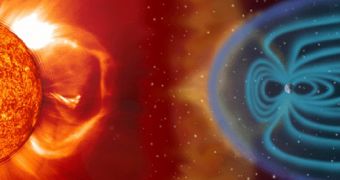Here on Earth, life is protected relatively well from the effects of deadly radiation, due to the planet's magnetic field, which forms a protective shield against electrically charged energetic sub-atomic particles. However, though it has been more than three decades since the last man walked on the surface of the Moon, there still is concern regarding the unknown effects of long term exposure to radiation of the lunar surface. This is not related only to the crew of a possible future manned mission to the Moon, as the Earth has a permanent crew in its orbit, aboard the International Space Station.
The danger of exposure to long term radiation while in space grows exponentially, when you take into consideration the solar storms that can propel particles at relativistic speeds toward the outer extremities of the solar system, and thus, towards the Earth as well. The solar wind carries so much energy, that the stream of particles passing through the planet's upper atmosphere heats up the oxygen and sends it toward our natural satellite, in the form of a hazardous emission of radiation.
Recent studies, made by the University of Washington, reveal the fact that the Moon is also protected in certain areas by the Earth magnetosphere, during seven of the twenty eight days it takes the Moon to complete an orbit around our planet.
The stream of highly energetic particles, contained in the solar winds, originate in the Sun's corona, its upper layer of the atmosphere, during magnetic storms, which eject high quantities of matter in the surrounding space. The energy released during these magnetic storms can be so powerful, that they can produce electromagnetic pulses strong enough to penetrate the planet's ionosphere, and to disrupt energy distribution and communication lines, or even to knock out satellites.
Also, during particle absorption in the ionosphere layer, they energize the oxygen rich layer, which determines a secondary particle emission process from the atmosphere towards space, which is not so dangerous for atmosphere as solar emissions are.
Usually, an energetic sub-atomic particle hitting a human body will pass directly through it, without provoking too much damage to the tissue. However, the low energy particles cannot pass through the whole mass of the human body and are captured by the cells, and usually, a sub-atomic particle is followed by many others, which could destroy a large number of living cells, if they present radioactive properties.
The longest manned mission ever to another body in the solar system took place during the Apollo 17 mission, when the astronauts on board the spacecraft spent eight days in an unprotected against radiation environment. The biggest problem though is not the fact that there is not enough protection against radiation, but rather that there is no warning before a solar storm. Most of the particle emissions from the Sun travel at relativistic speeds and, by the time the solar storm is detected, there is a good chance that it has already reached Earth.
Radiation poisoning can be responsible for the installation of certain diseases that provoke death, such as cancer or inoperable tumors, however it does not kill instantaneously. Models of the secondary emission of particles in Earth ionosphere suggest that these particles do not present any danger to future space missions.

 14 DAY TRIAL //
14 DAY TRIAL //